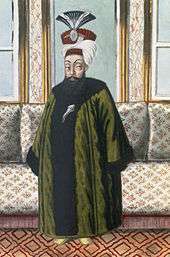Nakşidil Sultan
| Nakşidil Sultan | |
|---|---|
| Valide Sultan of the Ottoman Empire | |
| Tenure | 28 July 1808 - 22 August 1817 |
| Predecessor | Ayşe Seniyeperver Sultan |
| Successor | Bezmiâlem Sultan |
| Born |
19 December 1768 Caucasus |
| Died |
22 August 1817 (aged 48) Constantinople, Ottoman Empire |
| Burial | Constantinople |
| Spouse | Abdul Hamid I |
| Issue | Adoptive son Mahmud II |
| Religion | Islam or Roman Catholic |
Nakşidil Valide Sultan (fully Devletli, İsmetli, Nakşidil Valide Sultan Aliyyetü'ş-şân Hazretleri; 19 December 1768 – 22 August 1817; meaning "Embroidered on the Heart"[1])[2] was the consort of Ottoman Sultan Abdul Hamid I and Valide Sultan to her adoptive son Mahmud II.
Controversy over identity

There is a legend that she was the same person as Aimée du Buc de Rivéry, cousin of Empress Josephine, who went missing at sea at a young age: according to this myth, Aimée du Buc de Rivéry was captured by Barbary pirates and sold as a harem concubine, though there is no evidence of this. According to Necdet Sakaoğlu, Nakşîdil Sultan was Georgian. The story that Nakşîdil Sultan was Aimée du Buc de Rivéry is false. Aimée du Buc de Rivéry died while she was returning to Martinique island in 1790.[3]
Several older myths, dating back even to the early 16th century, already purported to identify connections between the French and the Ottoman monarchies, but have been found to be politically motivated fabrications, intended to justify alliances between the two (supposedly related) monarchies. The Aimée-Nakşidil tale shows several distinct parallels to these older tales. In times of monarchy, the stories about abducted French princesses weren't repudiated by French officials to maintain good relations with the Ottoman inventors of the tales. In later times this and similar harem tales have been used in France to perpetuate a view of Turkey, the Middle East and the Islam in general as mysterious and despotic in nature, despite more accurate accounts available.[4]
Supposed facts
According to the Ottoman Chronicles, the mother of Mahmud II was known by the Turkish name Nakşidil (Nakshidil) and died in 1817; all the women of the sultan were given Turkish names when they entered the harem.
The woman who was valide sultan during the period from 1808 to 1817 was supposedly very western and French-influenced; she was said to have given the Sultan French lessons, sent an embassy to Paris, and reformed the harem by giving the women permission to go on picnics and boat travels along the coasts outside the palace.
See also
- Ottoman Empire
- Ottoman dynasty
- Ottoman family tree
- List of Valide Sultans
- List of sultans of the Ottoman Empire
- Line of succession to the Ottoman throne
- Ottoman Emperors family tree (simplified)
- List of consorts of the Ottoman Sultans
Further reading
- Peirce, Leslie P., The Imperial Harem: Women and Sovereignty in the Ottoman Empire, Oxford University Press, 1993, ISBN 0-19-508677-5 (paperback).
- Yavuz Bahadıroğlu, Resimli Osmanlı Tarihi, Nesil Yayınları Ottoman History with Illustrations, Nesil Publications, 15th Ed., 2009, ISBN 978-975-269-299-2 (Hardcover).
References
- ↑ Harem: The Favourites
- ↑ "Images du patrimoine". Manioc. Retrieved 1 September 2010.
- ↑ Sakaoğlu, Necdet (2008). Bu mülkün kadın sultanları: Vâlide sultanlar, hâtunlar, hasekiler, kadınefendiler, sultanefendiler. Oğlak Publications. pp. 358–360. ISBN 978-9-753-29623-6.
- ↑ Christine Isom-Verhaaren: Royal French Women in the Ottoman Sultans' Harem
External links
| Ottoman royalty | ||
|---|---|---|
| Preceded by Ayşe Seniyeperver Sultan |
Valide Sultan 28 July 1808 - 22 August 1817 |
Succeeded by Bezmiâlem Sultan |